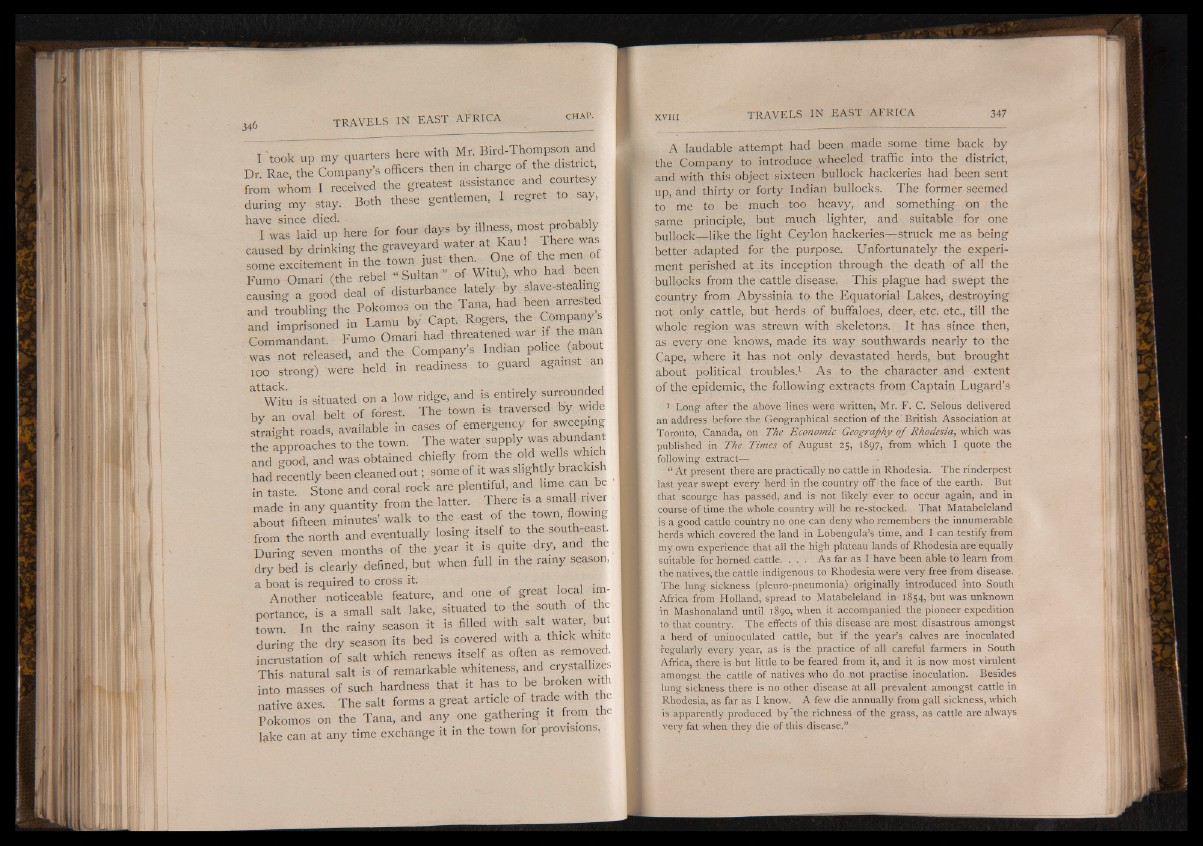
I 'took up my quarters here with Mr. frd-Thompsopand
Dr. Rae, the Company’s officers then a charge of the
from whom I received the greatest ass,stance ami
during my stay. Both these gentlemen, I regret to say,
h w " p here for four days " “ is
caused by drinking the graveyard water at Kau I S W d f e
some excitement in the town just then. One of the men ot
Fumo Omari“ L -b e l "Sultan" of Witu), who had been
causing a good deal of disturbance lately by slave-stealing
and troubling the Pokomos on the Tana, had been arrested
a n l imprisoned in Lamb by Capri Rogers£ * Companys
Commandant. Fumo Omari had threatened wa^ lf the ^ “
was not released, and the Company s Indian
100 strong) were held in readiness to guard against an
a tWiktu is situated on a low ridge, and is entirely surrounded
by an oval belt of forest. The town is traversed by wide
straight roads, available in cases of emergency for sweepm
the approaches to the town. The water supply was abundant
and good, and was obtained chiefly from the old wells wh ch
had recently been cleaned ou t; some of it was slightly brackis
in taste. Stone and coral rock are plentiful, and lime can be
made in any quantity from the latter. There is a small river
Xout fifteen minutes’ walk to the east of the town, flowing
from the north and eventually losing itself to A e so u th e a^
During seven months of the year it is quite diy, and the
dry bed is clearly defined, but when full in the rainy season,
a boat is required to cross it. - E B B sB
Another noticeable feature, and one of great local importance,
is a small salt lake, situated to the south of the
town. In the rainy season it is filled with salt water but
during the dry season its bed is covered with a thick white
incrustation of salt which renews itself as often as removed
This natural salt is of remarkable whiteness, and crystall z|
into masses of such hardness that it has to be broken with
native axes. The salt forms a great article of trade with th
Pokomos on the Tana, and any one gathering 1 rom
lake can at any time exchange it in the town for provisions,
A laudable attempt had been made some time back by
the Company to introduce wheeled traffic into the district,
and with this object sixteen bullock hackeries had been sent
up, and thirty or forty Indian bullocks. The former seemed
to me to be much too heavy, and something on the
same principle, but much lighter, and suitable for one
bullock— like the light Ceylon hackeries— struck me as being
better adapted for the purpose. Unfortunately the experiment
perished at its inception through the death of all the
bullocks from the cattle disease. This plague had swept the
country from Abyssinia to the Equatorial Lak;es, destroying'
not only cattle, but herds of buffaloes, deer, etc. etc., till the
whole region was strewn with skeletons. It has since then,
as every one knows, made its way southwards nearly to the
Cape, where it has not only devastated herds, but brought
about political troubles.1 As to the character and extent
of the epidemic, the following extracts from Captain Lugard’s
1 Long after the above lines were written, Mr. F. C. Selous delivered
a n address before the Geographical section of the! British Association at
Torpnto, Canada, on The Economic Geography o f Rhodesia, which was
published in The Times of August 25, 1897, from which I quote the
following extract—
“ At present there are practically no cattle in Rhodesia. The rinderpest
last year swept every herd in the country off the face of the earth. But
that scourge has passed, and is- not likely ever to occur again, and in
course of time the whole country will be re-stocked. That Matabeleland
is a good cattle country no one can deny who remembers the innumerable
herds which covered the land in Lobengula’s time, and I can testify from
my own experience that all the high plateau lands of Rhodesia are equally
suitable for horned cattle. . . . As far as I have been able to learn from
the natives, the cattle indigenous to Rhodesia were very free from disease.
The lung sickness (pleuro-pneumonia) originally introduced into South
Africa from Holland, spread to Matabeleland in 1854, but was unknown
in Mashonaland until 1890, when it accompanied the pioneer expedition
to that country. The effects of this disease are most disastrous amongst
a herd of uninoculated cattle, but if the year’s calves are inoculated
regularly every year, as is the practice of all careful farmers in South
Africa, there is but little to be feared from it, and it is now most virulent
amongst the cattle of natives who do not practise inoculation. Besides
lung sickness there is no other disease at all prevalent amongst cattle in
Rhodesia, as far as I know. A few die annually from gall sickness, which
is apparently produced by the richness of the grass, as cattle are always
very fat when they die of this disease,”